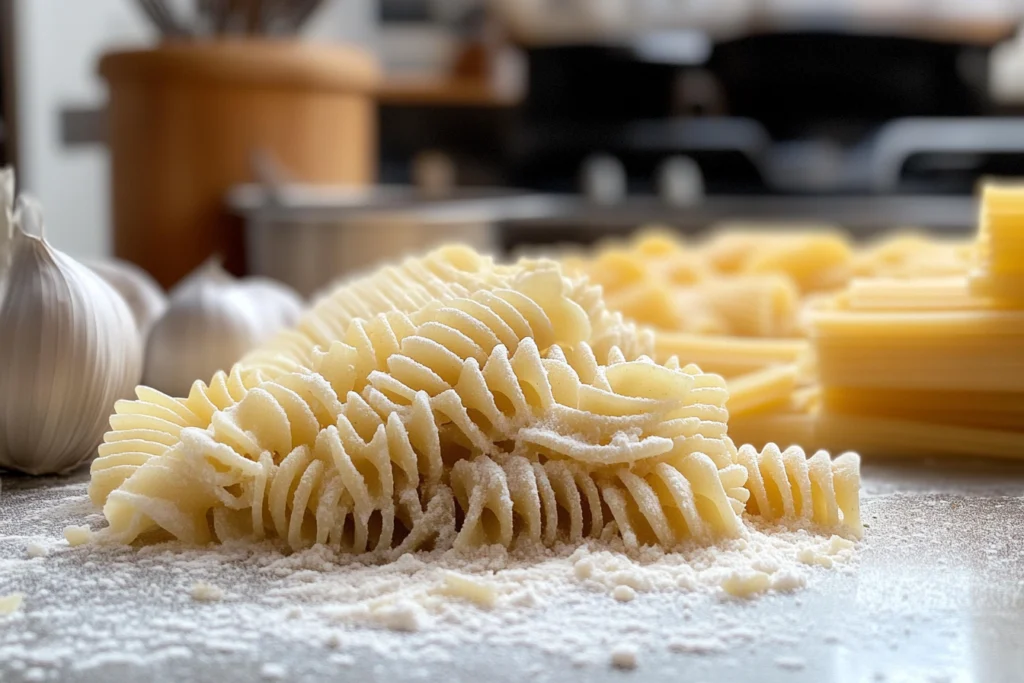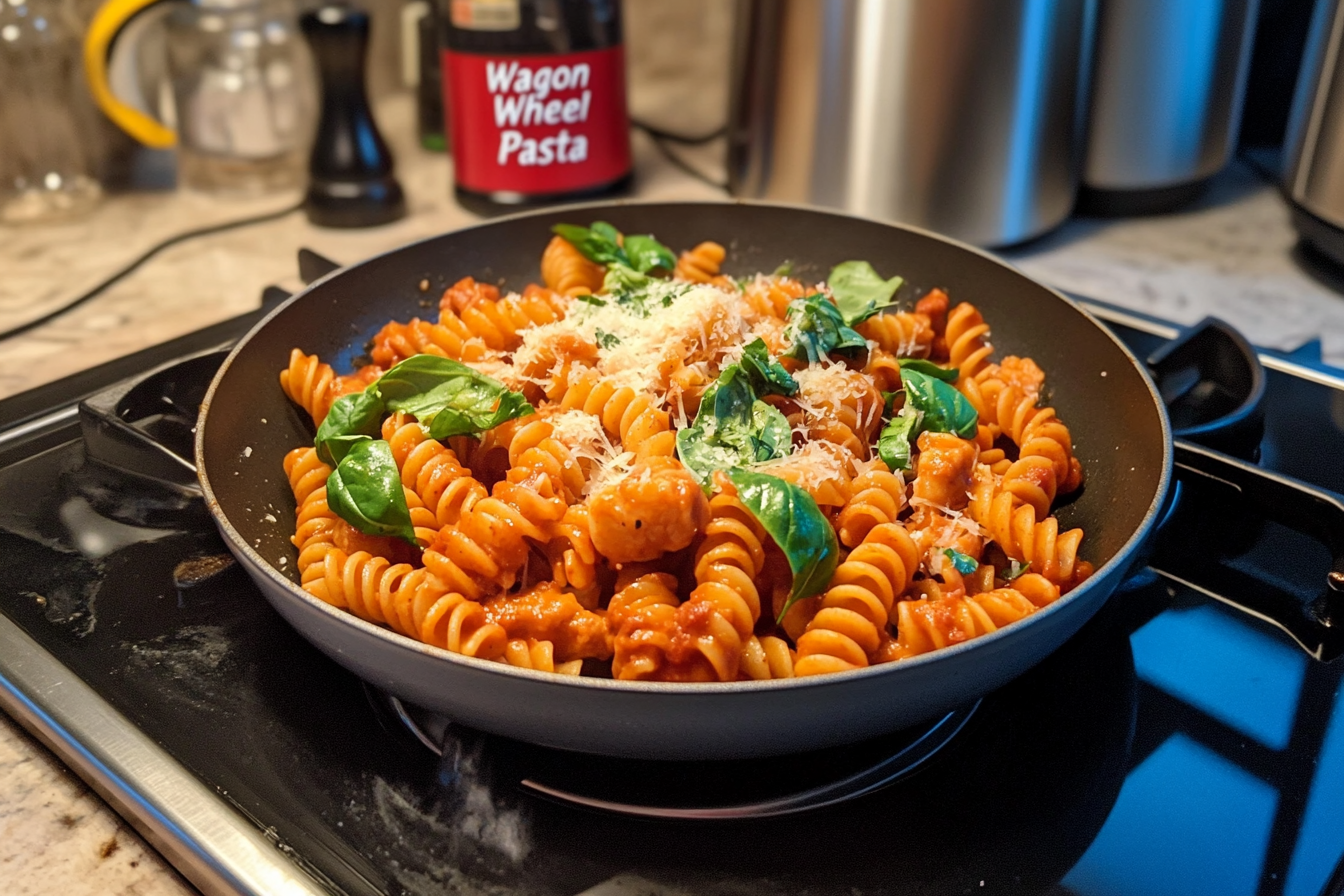What’s the Deal with Wagon Wheel Pasta?
I’ve always had a soft spot for Wagon Wheel Pasta Recipe, also called rotelle. It’s one of those pasta shapes that brings instant joy—maybe it’s the playful, spoked wheel design, or maybe it’s how it holds onto sauce like it was born to do it.
Whenever I make this pasta, whether it’s for a casual weeknight meal or a potluck salad, someone always asks, “What kind of pasta is this?!” That’s part of the charm.
The unique shape doesn’t just look good—it actually works. Those little ridges and hollow spokes are perfect for catching bits of sauce, meat, and veggies. I love how versatile it is, easily sliding into both kid-friendly dishes and elevated gourmet recipes.
Where It All Started: A Pasta With Roots
Even though I only discovered Wagon Wheel Pasta Recipe a few years ago, its roots go way back to Italy. It was inspired by—you guessed it—wagon wheels, symbols of progress and movement. That symbolism really resonates with me. It feels like a pasta that’s always going somewhere, always evolving.
I’ve read that it became especially popular in Italian-American households around the 1950s, probably because it stood out from more traditional shapes. Over time, chefs and home cooks started adapting it into all kinds of regional and international recipes. I’ve even tried it in Asian fusion dishes—and let me tell you, it works.
Why I Keep Coming Back to Wagon Wheel Pasta
There are a few pasta shapes that always have a spot in my pantry, and wagon wheel is one of them. Here’s why:
- It holds sauce like a champ.
- It has a satisfying chew thanks to the ridges and spokes.
- It keeps its shape during cooking—no soggy, shapeless noodles here.
- It’s just more fun to eat.
Whether I’m making a cold pasta salad or a hearty baked casserole, I love the way it brings both texture and visual appeal to the plate.
Let’s Talk Nutrition (Because I Care About That Too)
I’m not a nutritionist, but I do pay attention to what I eat—and Wagon Wheel Pasta Recipe fits right into my balanced approach to food.
Here’s what I usually get in a standard 2-ounce serving:
- Calories: About 200
- Protein: 7–8 grams
- Carbs: Around 40 grams
- Fat: Just 1 gram
If I’m buying the whole-grain or enriched version, I get a little fiber boost too—which is great for digestion and energy levels.
Fortified versions also add:
- Iron (for energy and focus)
- B Vitamins like folate and niacin
I often pair it with colorful veggies, lean proteins, and healthy fats, so it ends up being part of a pretty nutrient-dense meal.
How It Stacks Up Against Other Pasta Shapes
I’ve tried just about every pasta shape you can imagine—macaroni, penne, fusilli, spaghetti. They all have their place, but wagon wheel holds a special one for me.
Here’s how it compares:
- Sauce retention? Better than spaghetti, easily on par with penne.
- Texture? More bite than macaroni or fusilli.
- Shape durability? Holds up beautifully in baked dishes and one-pot meals.
So when I want a pasta that feels good to eat, especially in layered or saucy recipes, I know what to reach for.
Cooking Wagon Wheel Pasta Like a Pro
I used to overcook my pasta—just being honest. Now I’m all about that al dente life, and wagon wheels actually make it easier.
Here’s how I do it:
- Use lots of water: 4–6 quarts per pound.
- Salt generously: A tablespoon goes in once the water’s boiling.
- Set a timer: 8–10 minutes is the sweet spot. I start tasting around 8.
Pro tip: Don’t rinse your pasta! The starch helps sauce cling.
When I want to keep the shape intact (especially for a pasta salad), I stir gently and avoid crowding the pot. It really does make a difference.
My Favorite Sauces to Pair with Wagon Wheel Pasta
One of the reasons I keep reaching for Wagon Wheel Pasta Recipe is how it complements different sauces. Some pairings are just too good not to share:
🧀 Creamy Sauces
- Alfredo with Parmesan: Indulgent and rich. I toss in grilled chicken and a handful of peas.
- Cheddar cheese sauce: Think mac-and-cheese, but elevated.
🍅 Tomato-Based Sauces
- Marinara: Simple, classic, can’t go wrong.
- Arrabbiata: When I want a spicy kick, this is the one.
🫒 Lighter Olive Oil-Based Options
- Garlic, lemon, and herb drizzle with sautéed veggies—fresh and flavorful.
- Sometimes I add a spoonful of pesto for a bit more punch.
These lighter dressings let the pasta’s texture shine. Plus, they’re ideal for summer meals or quick lunches.
Crowd-Pleasing Wagon Wheel Pasta Recipes I Swear By
Here are a few go-to recipes that I keep in rotation, especially when I need something easy, reliable, and delicious.
1. Wagon Wheel Pasta Salad
This is a potluck MVP. I make it year-round, but it shines in summer.
Ingredients I use:
- Cooked wagon wheel pasta
- Cherry tomatoes
- Olives
- Feta cheese
- Zesty Italian dressing
Bonus: It travels well and tastes better the next day.
2. Baked Wagon Wheel Casserole
This one’s for when I want comfort food.
What goes in:
- Marinara sauce
- Ground beef or Italian sausage
- Mozzarella + Parmesan
- Sometimes a layer of ricotta
I bake it until everything bubbles and the cheese gets that golden top. So satisfying.
3. One-Pot Veggie Wagon Wheel Pasta
Weeknight favorite alert!
Here’s my quick version:
- Start with garlic and olive oil in a big pot
- Add zucchini, bell peppers, spinach
- Stir in cooked pasta
- Finish with crumbled feta and a splash of lemon juice
Cleanup is a breeze, and the flavor’s amazing.
Why Kids and Picky Eaters Love It
Let’s be real—getting kids to eat veggies is a whole thing. That’s why I love sneaking them into wagon wheel pasta dishes. The fun shape distracts them, and the sauces hide the greens.
My tricks:
- Puree carrots or spinach into tomato sauce. It adds sweetness and color.
- Mix colorful veggies like peas and bell peppers right into the pasta.
- Use cheese generously. Melted mozzarella or cheddar makes everything taste better to little mouths.
If it looks like a fun meal, kids are more likely to give it a try.
Creative Ways I Mix It Up
Wagon wheel pasta might have Italian roots, but I love using it in all kinds of dishes. It’s the kind of ingredient that welcomes experimentation.
Italian-Inspired:
- Bolognese sauce with a long simmer for deep flavor.
- Pasta Puttanesca with anchovies, olives, capers—salty and bold.
American Comfort Food:
- Mac and Cheese Bake with crispy breadcrumb topping.
- Chili Casserole with beans, cheddar, and spicy ground beef.
Asian Fusion:
- Sesame-Soy Pasta Salad with shredded carrots and edamame.
- Thai Peanut Wagon Wheels with chopped scallions and crushed peanuts.
The possibilities are endless, which keeps things interesting in the kitchen.

How I Make the Most of Wagon Wheel Pasta in My Kitchen
My Go-To Ingredient Pairings for Wagon Wheel Pasta
One thing I love most about Wagon Wheel Pasta Recipe is how easily it plays well with so many ingredients. Depending on the season—or just what I’ve got in the fridge—I can build a dish around whatever protein or veggie is on hand.
🥩 Protein Pairings That Work Every Time
1. Chicken
Chicken is such a safe bet. It’s mild, easy to cook, and blends beautifully with almost any sauce.
- I often grill some chicken breasts, slice them up, and toss them with Alfredo and wagon wheel pasta.
- On busy nights, rotisserie chicken + marinara + a sprinkle of mozzarella = dinner in 20 minutes.
2. Ground or Sliced Beef
If I’m craving something hearty, beef is the answer.
- A simple meat sauce over al dente wheels is pure comfort.
- I’ve also pan-seared thin steak slices, tossed them with olive oil, garlic, and parsley, and folded everything into warm pasta. It feels elevated but takes 15 minutes.
3. Tofu
Yes—wagon wheels work in vegetarian dishes too.
- I cube and sauté tofu with sesame oil and a splash of soy sauce, then mix it with a spicy tomato or peanut sauce and toss it with the pasta.
- Bonus points for adding crunchy veggies like red cabbage or carrots.
🥦 Veggie Pairings I Always Come Back To
Sometimes, all I want is a veggie-forward dish that still satisfies. Wagon wheels can handle it.
Zucchini
I love slicing zucchini thin and sautéing it with garlic and olive oil. The mild flavor complements the pasta’s neutral base, and the combo feels fresh and summery.
Spinach
One of my favorite quick tricks: throw fresh baby spinach into the pot right after draining the pasta. The residual heat wilts it perfectly.
Mushrooms
Earthy mushrooms like cremini or portobellos bring so much umami. They’re especially delicious with a bit of butter, garlic, and thyme stirred into the pasta.
Cheese, Please: My Favorite Melty & Crumbly Pairings
I’ll admit it—I’m a cheese lover. And Wagon Wheel Pasta Recipe gives me the perfect excuse to go a little overboard sometimes.
Parmesan
- I use it as a finishing touch more than anything.
- A generous sprinkle on top of a tomato or cream-based dish adds that nutty, salty depth I crave.
🧀 Mozzarella
- If I’m making a baked pasta dish, mozzarella is non-negotiable.
- That stretchy, gooey pull when you scoop it out of the pan? Heaven.
🧀 Feta
- For cold pasta salads, I go with feta.
- It adds a tangy bite that works beautifully with olives, tomatoes, or a lemon vinaigrette.
Wagon Wheel Pasta: The Ultimate Kid-Friendly Hack
I have nieces and nephews who are super picky eaters, and wagon wheel pasta is the one food that never fails. There’s something about the shape—it’s fun, familiar, and easy to scoop with a spoon.
My Kid-Approved Strategies
- Bright sauces: Think pink vodka sauce, orange cheese sauce, or green pesto—they’re eye-catching and delicious.
- Tiny veggies in disguise: I’ll puree carrots or butternut squash into the cheese sauce. The kids never know!
- Colorful garnishes: Peas, corn, bell peppers—they add natural pops of color without overwhelming little palates.
It’s also a great way to get kids involved in the kitchen. I let them help sprinkle cheese or stir the pasta, which makes them more excited to eat it.
Around the World in Wagon Wheels
I love that something so Italian in origin can be global in flavor. Here’s how I’ve used wagon wheel pasta to explore the world through food.
🇮🇹 Italian-Inspired Recipes
- Wagon Wheel Bolognese: Slow-cooked ground beef, tomato paste, and red wine—it clings to the wheels and becomes this incredibly satisfying dish.
- Pasta Puttanesca: Briny, bold, and a little spicy. The spokes of the pasta catch bits of capers and anchovies, making every bite pop.
🇺🇸 American Comfort Food
- Mac and Cheese Bake: I swap elbow macaroni with wagon wheels for a twist. The cheese coats every curve and cranny.
- Chili Pasta Casserole: I layer cooked wagon wheels with ground beef, beans, cheddar, and chili seasoning—it’s Tex-Mex meets Italian.
🌏 Asian-Inspired Twists
I know it’s not traditional, but trust me, these flavors totally work.
- Sesame Soy Wagon Wheel Salad: With edamame, shredded carrots, and scallions. Add a dash of rice vinegar and sesame seeds to finish.
- Thai Peanut Pasta: Creamy peanut sauce, sriracha, chopped cilantro, and crushed peanuts. It’s rich, nutty, and a little spicy—so satisfying.
Making Wagon Wheel Pasta Work for All Diets
We’ve got a few dietary needs in my household, so I’ve learned to adapt.
Gluten-Free Options
Luckily, more brands are offering gluten-free Wagon Wheel Pasta made from:
- Rice flour
- Corn flour
- Chickpea or lentil flour
They hold their shape well and still give me that satisfying bite. I just keep an eye on the cooking time—they tend to soften quicker.
Vegan and Vegetarian Friendly
I make vegan versions of Alfredo using:
- Cashew cream
- Nutritional yeast
- Garlic and lemon
And when I want to keep it vegetarian, I’ll go for roasted veggie combinations with olive oil and fresh herbs. No one misses the meat.
Low-Carb & Keto Swaps
Okay, so there isn’t a true low-carb wagon wheel, but I’ve experimented with spiralized zucchini or shirataki noodles to get the same circular vibe. I dress them up with similar sauces, and it still feels like I’m eating pasta—without the carb crash.
How I Serve Wagon Wheel Pasta for Maximum Wow Factor
You know those dishes that look fancier than they are? Wagon wheel pasta helps me pull that off.
Simple Presentation Tips
- I use shallow bowls so the pasta looks layered and abundant.
- A drizzle of olive oil or balsamic glaze right before serving adds sheen and flavor.
- A final dusting of fresh herbs (like basil or parsley) makes it restaurant-worthy.
Garnishes That Add Crunch and Color
I’m obsessed with textures, so I always finish with something crispy.
- Toasted pine nuts for creamy sauces
- Sunflower seeds on olive oil-based pastas
- Crushed croutons or panko on baked dishes
It’s all about the balance: soft pasta, rich sauce, and that little surprise crunch.
My Favorite Meals Featuring Wagon Wheel Pasta
Let me share a few combinations that have been total hits—whether I’m cooking for family, friends, or just myself after a long day.
🍤 Wagon Wheel Pasta with Shrimp and Garlic Butter
- Sauté shrimp in butter and garlic
- Add lemon zest and parsley
- Toss with cooked wagon wheels and serve immediately
Light, bright, and full of flavor.
🌱 Wagon Wheel Primavera
- I load this up with seasonal veggies—think asparagus, cherry tomatoes, and snap peas
- Add olive oil, a sprinkle of chili flakes, and a shower of Parmesan
- It tastes like spring in a bowl
🍲 Wagon Wheel Soup
When I want something warm and comforting, this is my go-to.
- Use a tomato-based broth
- Add diced veggies and cannellini beans
- Drop in the pasta toward the end so it stays al dente
The wheels give a chewy contrast to the soft broth and tender vegetables.
More FAQs I Get About Wagon Wheel Pasta
Here are some questions I’ve been asked by friends, family, and readers—plus my best answers.
- Can I meal-prep with wagon wheel pasta?
Absolutely. It holds up better than most in the fridge, especially for cold salads or casseroles. - Is it hard to find gluten-free wagon wheel pasta?
It’s not super common, but brands like Jovial or Banza sometimes offer it. Online shops are your best bet. - What’s the best sauce for kids?
Cheddar cheese sauce or a mild marinara—nothing too spicy or chunky. - Can I use it in baked dishes?
Yes, and it’s fantastic. It holds its shape and gets golden on top if you add cheese. - Is it good for soups?
Totally. It’s sturdy enough to soak in broth without falling apart. - Do I need a special tool to make wagon wheels from scratch?
If you’re making them at home, yes—you’ll need a mold or cutter. Otherwise, buy pre-made and save the time. - How do I stop pasta from sticking after cooking?
Toss it with olive oil or a bit of sauce immediately after draining. - What herbs go best with it?
Basil, parsley, oregano, thyme—fresh is best, but dried works too. - How do I store leftovers?
Use an airtight container and keep it in the fridge for 3–5 days. Toss with oil before storing to prevent clumping. - What makes wagon wheel pasta different?
It’s the shape! The wheels hold sauce better and offer a unique, satisfying bite.

